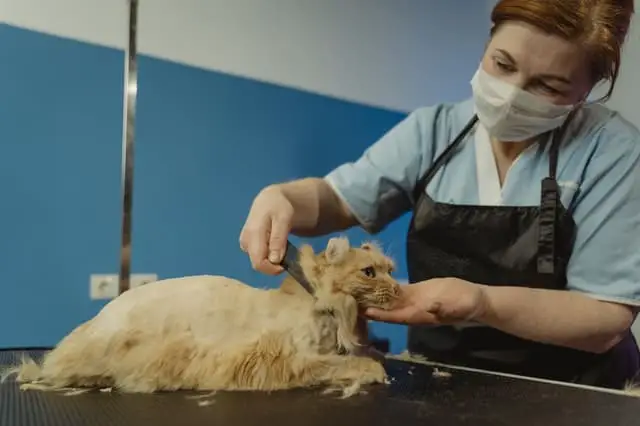
When the heat arrives, the fur of our pets seems like a hood of heat. But is shearing the cat in the summer useful for the cat or harmful to its health?
One of the most common questions cat owners ask themselves (and ask their veterinarians or pet experts) is whether to shear their cat in the summer to get some relief from the sweltering heat. After all, why not? The kitty wears a heavy fur coat in the summer heat, why shouldn’t we get him to take it off a little? It’s actually not that simple. There are many factors to consider, and it is important to know them to preserve the health of our cat even if our intentions are the best. So, before taking our cat to the groomer, let’s first analyze the pros and cons of shearing it.
Shaving the cat in the summer: yes or no?
In a word: no. It’s more complicated than that, though. Our cat’s fur has many functions, and is an excellent insulator. Not only does his coat keep him warm during cold weather, it can also keep him cooler in hot weather by trapping cool air against his skin. Nature has designed its fur exactly as it should be.
That said, it is absolutely okay to want to give our cat a “summer cut” to help him cool down, shed less hair, and generally so that his fur becomes less tangled and matted. It is best to have a professional groomer to trim our cat’s fur – we must never try to do it ourselves with scissors! And let’s make sure we leave at least an inch or more of fur, to make sure your cat’s coat retains its insulating properties.
Is shaving the cat therefore wrong?
It’s not necessarily bad to shear your cat in the summer, but it just doesn’t need it. Not only that, completely shaving his fur can be quite risky for a variety of reasons.
Removing all of its fur can actually make it more prone to overheating. It can also make him more prone to getting bitten by insects or getting sunburns, which can eventually even lead to skin cancer. There are, of course, some specific cases where it makes sense to clip a cat, such as before surgery, or if its fur becomes so dull that it needs to be removed.
Summer is not one of those cases. And, given the health risks that our cat presents when it is shaved, it is best to avoid “trendy” hair cuts even though, we know, our cat could look really great if shaved like a lion! But the game isn’t worth it.
Should we shear an indoor cat?
Indoor cats should be able to find a place where they can stay cool enough when indoors. They can rest effortlessly if necessary, are not in direct sun, and should always have a source of fresh, clean water to draw from.
Therefore, it is not necessary to shear the cat in the summer if it is an indoor cat. However, he may need to be shaved or have his coat clipped for other reasons , including lack of personal care, which results in knots and / or skin conditions that need air, and medications to fix such problems.
Should an outdoor cat be shorn in the summer?
A cat’s fur has more purposes than just keeping our furry pet warm. Here are some other functions of our cat’s coat:
- Protects the skin from injury, including sunburn.
- Help the cat communicate with others of its kind. For example, a cat with raised fur indicates that she is angry or defensive. This could tell other cats not to approach.
- It serves as an insulator, keeping the cat warmer in the cold season, and cooler in the warm season.
Shaving an outdoor cat can remove its protection from the sun and leave it vulnerable to various injuries that could instead be blocked by its fur. In most cases, it is a better idea, rather than shearing your cat in the summer, to keep it indoors on very hot days. However, it is a great idea to keep our cat well cared for by brushing him often and looking for any lesions or other conditions of his skin.
Other notes on cat shaving
Shaving cats can result in skin nicks or ingrown hairs as the hair begins to grow back, which can lead to skin infections and an abnormal coat. Sometimes it’s necessary, but when it is, it ‘s probably best to let veterinary staff or a qualified groomer do the work .
Cats can overheat and die from heatstroke. This is more common in some breeds than others, especially brachycephalic cats or those with short noses. Dark-haired, overweight, or long-haired cats may also be at increased risk of overheating. We should be especially diligent about bringing those cats indoors in hot weather, and make sure they have plenty of fresh water available.
Some cats, usually those with short faces and long hair, are unable to groom and care for themselves effectively, and those cats may benefit from regular hair trimming or the ability to shave. Our vet can help us decide if our kitty is one of these.
What about the shedding?

Shedding is annoying, sure, but it’s also one of the most reliable signs of a healthy cat. Our kitty will lose its fur throughout the year, but we may notice an increase in shedding during the warmer months of the year.
Rather than shearing the cat in the summer, however, we need to be more attentive to the care of the fur. Brush him / her twice a day with a vet-approved hairbrush, and give him / her many places and opportunities to brush, to remove as much loose hair as possible.
But even with such well-designed insulating fur, cats get hot. The good news is that cats are pretty good at moving to a cooler place when they feel too hot. Always make sure that the cat has a place to go that is shady, and has plenty of water. And, of course, we never leave the cat in an enclosed outdoor space, such as a car or garage, for any length of time when it’s hot outside.






